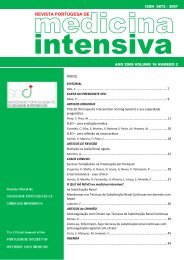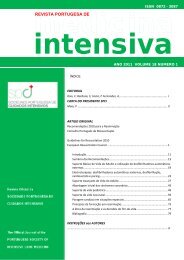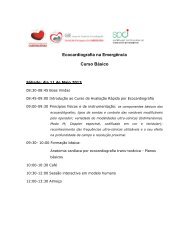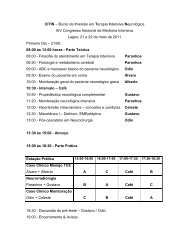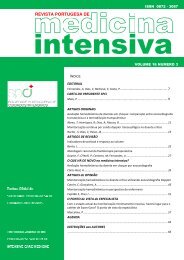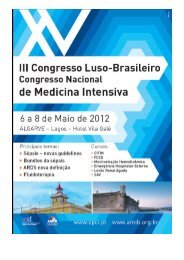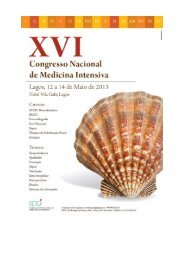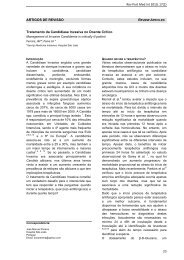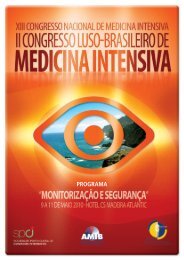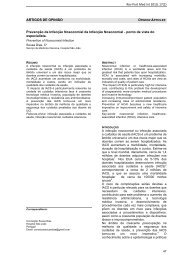Setembro de 2011 - Vol 18 numero 3 - Sociedade Portuguesa de ...
Setembro de 2011 - Vol 18 numero 3 - Sociedade Portuguesa de ...
Setembro de 2011 - Vol 18 numero 3 - Sociedade Portuguesa de ...
Create successful ePaper yourself
Turn your PDF publications into a flip-book with our unique Google optimized e-Paper software.
Rev Port Med Int <strong>2011</strong>; <strong>18</strong>(3)<br />
<strong>de</strong>tecção, sem que haja um diagnóstico<br />
complementar <strong>de</strong>terminado, sem tratamento<br />
efetivo. Estudar o <strong>de</strong>lirium é caminhar por<br />
“caminhos nunca (ou quase nunca) dantes<br />
navegados”. Com esta revisão, preten<strong>de</strong>u-se<br />
objetivar alguns pontos da fisiopatogenia do<br />
22<br />
<strong>de</strong>lirium, bem como sugerir diretrizes futuras<br />
(Tabela 2) no estudo <strong>de</strong> afecção fortemente<br />
prevalente nas unida<strong>de</strong>s <strong>de</strong> terapia intensiva e<br />
que é por nós, profissionais <strong>de</strong> saú<strong>de</strong>,<br />
imensamente negligenciada.<br />
1. Padronizar um termo para o <strong>de</strong>lirium em terapia intensiva. Propomos que, tal e qual os<br />
síndromes da resposta inflamatória aguda, da disfunção respiratória aguda, o <strong>de</strong>lirium <strong>de</strong>ve<br />
ser consi<strong>de</strong>rado como parte <strong>de</strong> uma síndrome da disfunção cerebral aguda.<br />
2. É mister estudar os fatores <strong>de</strong> risco associados à internação em UTI, particularmente a<br />
influência do ambiente no surgimento do <strong>de</strong>lirium, ruptura do ciclo sono-vigília, procedimentos<br />
invasivos, ausência <strong>de</strong> familiares, solidão, dor persistente, gravida<strong>de</strong> da doença <strong>de</strong> base.<br />
3. Não se sabe ao certo as razões <strong>de</strong> certos pacientes <strong>de</strong>senvolverem quadro hiperativo e<br />
outros, pelo contrário, apresentarem hipoativida<strong>de</strong>, tampouco o porquê <strong>de</strong> outros<br />
apresentarem variabilida<strong>de</strong> no <strong>de</strong>correr da internação, com períodos <strong>de</strong> hipervigilância e <strong>de</strong><br />
estado <strong>de</strong> alerta reduzido, sendo necessário estudar a fenomenologia mais acuradamente,<br />
tentando <strong>de</strong>terminar a fisiopatologia <strong>de</strong> tais subtipos.<br />
4. Os mo<strong>de</strong>los experimentais <strong>de</strong> <strong>de</strong>lirium em animais <strong>de</strong>ixam a <strong>de</strong>sejar no sentido <strong>de</strong> que<br />
produzem tipos específicos da alteração. Dever-se-ia criar mo<strong>de</strong>los experimentais que<br />
pu<strong>de</strong>ssem simular a via final comum da fisiopatogênese do <strong>de</strong>lirium.<br />
Tabela 2 - Priorida<strong>de</strong>s Futuras<br />
BIBLIOGRAFIA<br />
1. Ely EW; Margolin R; Francis J; et al.<br />
Evaluation of <strong>de</strong>lirium in critically ill patients:<br />
Validation of the Confusion Assessment Method for<br />
the Intensive Care Unit (CAM-ICU). Crit Care Med<br />
2001; 29: 1370 – 1379.<br />
2. Jacobi J; Fraser GL; Coursin DB; et al. Clinical<br />
practice gui<strong>de</strong>lines for the sustained use of<br />
sedatives and analgesics in the critically ill adult.<br />
Crit Care Med 2001; 30: 119 – 141.<br />
3. Pun BT; Ely EW. Managing ICU Delirium.<br />
Chest 2007; 132: 624 – 636.<br />
4. Ely EW; Siegel MD; Inouye SK. Delirium in the<br />
Intensive Care Unit: An Un<strong>de</strong>r-Recognized<br />
Syndrome of Organ Dysfunction. Semin Respir Crit<br />
Care Med 2001; 22: 115 – 126.<br />
5. Ely EW; Shintani A; Truman B. Delirium as a<br />
Predictor of Mortality in Mechanically Ventilated<br />
Patients in the Intensive Care Unit. JAMA 2004;<br />
291: 1753 – 1762.<br />
6. Thomason JWW; Shintani A; Peterson JF; Pun<br />
BT; Jackson JC; Ely EW. Intensive care unit<br />
<strong>de</strong>lirium is an in<strong>de</strong>pen<strong>de</strong>nt predictor of longer<br />
hospital stay: a prospective analysis of 261 nonventilated<br />
patients. Crit Care 2005; 9: R375 – R381.<br />
7. Ely EW; Gautam S; Margolin R; et al. The<br />
impact of <strong>de</strong>lirium in the intensive care unit on<br />
hospital length of stay. Intensive Care Med 2001;<br />
27: <strong>18</strong>92 – 1900.<br />
8. Fleminger S. Remembering <strong>de</strong>lirium. Br J<br />
Psychiatry 2002; <strong>18</strong>0: 4 – 5.<br />
9. American Psychiatric Association: Diagnostic<br />
and Statistical Manual of Mental Disor<strong>de</strong>rs, 3rd ed.<br />
Washington, DC. American Psychiatric Association,<br />
1980.<br />
10. Pandharipan<strong>de</strong> P; Jackson J; Ely EW.<br />
Delirium: acute cognitive dysfunction in the critically<br />
ill. Curr Opin Crit Care 2005; 11: 360 – 8.<br />
11. McGuire BE; Basten CJ; Ryan CJ; Gallagher<br />
J. Intensive Care Unit Syndrome: A dangerous<br />
misnomer. Arch Intern Med 2000; 160: 906 – 9.<br />
12. Inouye SK. Delirium in Ol<strong>de</strong>r Persons. N Engl<br />
J Med 2006; 354: 1157 – 65.<br />
13. Inouye SK. The dilemma of <strong>de</strong>lirium: clinical<br />
and research controversies regarding diagnosis and<br />
evaluation of <strong>de</strong>lirium in hospitalized el<strong>de</strong>rly medical<br />
patients. Am J Med 1994; 97: 278 – 88.<br />
14. Ely EW; Stephens RK; Jackson JC; et al.<br />
Current opinions regarding the importance,<br />
diagnosis, and management of <strong>de</strong>lirium in the<br />
intensive care unit: A survey of 912 healthcare<br />
profissionals. Crit Care Med 2004; 32: 106 – 112.<br />
15. Inouye SK; Rushing JT; Foreman MD; Palmer<br />
RM; Pompei P. Does Delirium Contribute to Poor<br />
Hospital Outcome? J Gen Intern Med 1998; 13: 234<br />
– 42.<br />
16. Levkoff SE; Evans DA; Liptkin B; et al.<br />
Delirium: the occurrence and persistence of<br />
symptoms among el<strong>de</strong>rly hospitalized patients. Arch<br />
Intern Med 1992; 152: 334 – 40.<br />
17. Peterson JF; Pun BT; Dittus RS; et al. Delirium<br />
and Its Motoric Subtypes: A Study of 614 Critically Ill<br />
Patients. J Am Geriatr Soc 2006; 54: 479 – 84.<br />
<strong>18</strong>. Sloss EM; Solomon DH; Shekelle PG; et al.<br />
Selecting target conditions for quality of care<br />
improvement in vulnerable ol<strong>de</strong>r patients. J Am<br />
Geriatr Soc 2000; 48: 363 – 9.<br />
19. Milbrandt EB; Deppen S; Harrison PL. Costs<br />
associated with <strong>de</strong>lirium in mechanically ventilated<br />
patients. Crit Care Med 2004; 32: 955 – 62.<br />
20. Inouye SK; Zhang Y; Jones RN; Kiely DK;<br />
Yang F; Marcantonio ER. Risk factors for <strong>de</strong>lirium at<br />
discharge: Development and validation of a<br />
predictive mo<strong>de</strong>l. Arch Intern Med 2007; 167: 1406<br />
– 13.<br />
21. Trzepacz PT. Anticholinergic mo<strong>de</strong>l for<br />
<strong>de</strong>lirium. Semin Clin Neuropsychol 1996; 1: 294 –<br />
303.<br />
22. Crippen D. Agitation in the ICU: part one.<br />
Anatomical and physiologic basis for the agitated<br />
state. Crit Care 1999; 3: R35 – R46.<br />
23. Trzepacz PT. Update on the<br />
Neuropathogenesis of Delirium. Dement Geriatr<br />
Cogn Disord 1999; 10: 330 – 4.<br />
24. Tune LE; Egele S. Acetylcholine and Delirium.<br />
Dement Geriatr Cogn Disord 1999; 10: 342 – 4.



